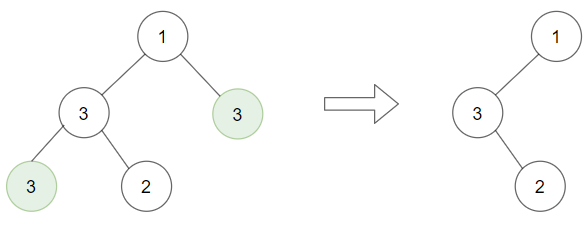题目¶
原题地址:https://leetcode.com/problems/delete-leaves-with-a-given-value/
Given a binary tree root and an integer target, delete all the leaf nodes with value target.
Note that once you delete a leaf node with value target, if it's parent node becomes a leaf node and has the value target, it should also be deleted (you need to continue doing that until you can't).
Example 1:

Input: root = [1,2,3,2,null,2,4], target = 2 Output: [1,null,3,null,4]
Explanation: Leaf nodes in green with value (target = 2) are removed (Picture in left). After removing, new nodes become leaf nodes with value (target = 2) (Picture in center).
Example 2:

Input: root = [1,3,3,3,2], target = 3 Output: [1,3,null,null,2]
Example 3:

Input: root = [1,2,null,2,null,2], target = 2 Output: [1]
Explanation: Leaf nodes in green with value (target = 2) are removed at each step.
Example 4:
Input: root = [1,1,1], target = 1 Output: []
Example 5:
Input: root = [1,2,3], target = 1 Output: [1,2,3]
Constraints:
- 1 <= target <= 1000
- The given binary tree will have between 1 and 3000 nodes.
- Each node's value is between [1, 1000].
解法¶
前序遍历二叉树,在遍历的过程中重建二叉树,将符合条件的节点删除(节点没有子节点并且节点的值等于 target )
这个方法的 Python 代码类似下面这样:
# Definition for a binary tree node.
# class TreeNode(object):
# def __init__(self, val=0, left=None, right=None):
# self.val = val
# self.left = left
# self.right = right
class Solution(object):
def removeLeafNodes(self, root, target):
if root is None:
return
if root.left is None and root.right is None and root.val == target:
return
root.left = self.removeLeafNodes(root.left, target)
root.right = self.removeLeafNodes(root.right, target)
# 应对 note 提到的 case:
# Note that once you delete a leaf node with value target,
# if it's parent node becomes a leaf node and has the value target,
# it should also be deleted (you need to continue doing that until you can't).
if root.left is None and root.right is None and root.val == target:
return
return root
Comments